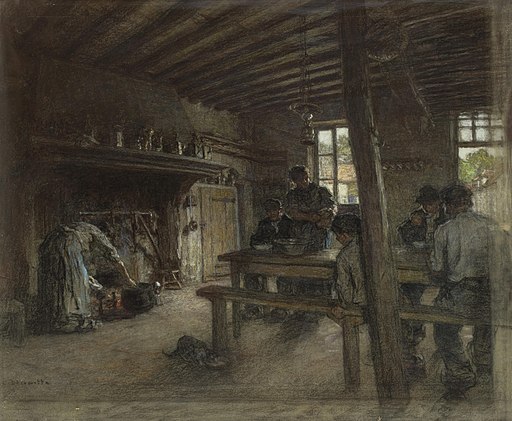
La paye des moissonneurs, 1882
Born July 31, 1844 in northern France, Léon Augustin Lhermitte was a French Realist painter. His work is characterized by rural scenes of peasant farmers much like his contemporaries such as Jean-François Millet and Jules Breton. Lhermitte, in contrast to these great painters, is lesser known yet his approach is more Classical and he had a much greater understanding of anatomy and body language.
In the above painting, La paye des moissonneurs, translated as the pay of harvesters, peasant farmers are given a day's wages for hard work from their landowners. You can tell by the way the figures to the left are seated on a concrete bench how defeated and tired they are yet eager for their pay, a biting comment on labor that we can all understand today, even with our modern conveniences. The man on the left is seated with his giant scythe, staring into space while his wife breastfeeds their child as the owner pays them in coins. The younger bachelor off to the right stands tall and proud as he accepts his meager wages from a landowner holding a bag of money, still unaware that his effort will be exploited until he eventually becomes like the tired man on the left. What an incredible narrative Lhermitte illustrates here. A handful of figures, neutral palette and body language with facial expressions only on the men. Note how his use of hands is a key element in telling the story in all of the figures. Lhermitte's social realism here is a triumph of the human condition.

La Fileuse, ca. 1800's
Lhermitte takes inspiration from Las Hilanderas by Velázquez yet forgos the Greek mythology of Arachne and instead uses a solitary spinner. In the painting by Velázquez, the theme is often considered an allegory on the Arts and how the craft and labor together of both master and pupil require a total effort while here Lhermitte suggests the effort is strictly solitary, requiring more of focus and discipline. The spinner's pose is almost reminiscent of Michelangelo's Libyan Sybil. Lhermitte uses an interesting choice of fabric and color on the spinner from violet to blue, then a greyed blue with yellow specs, with the red shoes as an accent. The room itself is bathed in warm tones of iron-specked stone of the walls with a deep shadow in the center of the composition.

Les Glaneurs, 1887
Here Lhermitte takes inspiration from his contemporary that he idolized—
Millet—and reinterprets the theme more harshly with loose, dry brushwork and a completely different palette. Where Millet used a predominantly soothing, grey-green, Lhermitte focuses instead on the scant leftover wheat in a gritty ochre as the subject, with the women as strong and independent. Millet's women are essentially faceless and unimportant as he emphasizes their under-appreciated work as servile and obedient. Lhermitte uses physicality and body language to really emphasize the backbreaking work in a kind of heroic way while using a low horizon line—in contrast to Millet's serene, flat field—portraying them sloped on a barren hillside. The women are also portrayed as both young and old, equally hardworking in the same environment. The same theme yet two very different approaches, and both important. I like the grittiness of Lhermitte's. Even the folds of their clothing has a rough texture to it.
Compare with Millet's The Gleaners

Le Repas des Ouvriers à la Ferme, pastel, ca. 1900's
An example of Lhermitte's pastel work, revealing a natural use of chiaroscuro in this simple, monochromatic study. Translating to The Meal of the Workers at the Farm, a woman prepares food for a hungry bunch. Note the pockets of color through the windows outside, which add much needed contrast and light to an otherwise dimly-lit room. Even the way Lhermitte adds a few whisps of rim-light on the woman's hair and face at the table as she breaks bread adds to the scene. This works so well as a pastel, it doesn't require the detail and richness of oils.

Le Vin, ca. 1800's
A more broad palette of color and light that shows Lhermitte's Classical influence. The man prods his wife to bring more wine for his guest, yet his wife, holding her daughter in one arm and the hand of her son on the other, sees that maybe their guest has had enough while the other two guests look on with full glasses in their hands. A very interesting social commentary that once again has very modern themes. Lhermitte's women are not only strong and caring mothers, but no fools either.

Haymaking, 1887
A beautiful work, Lhermitte portrays a man fixing the blade of a scythe while a young couple attempt to enjoy a rare moment of brief intimacy—a play on the expression a roll in the hay, perhaps— while their innocent young one seems eager to get back in the fields. One can feel the wind blowing through the grass on this farm somewhere in northern France. Zoom in to see the vibrant brushstrokes in the blades of grass, and the deep warm shadow in the distance suggesting perhaps imminent rain.
Lhermitte's realism is a poetry that not only captures the lives of peasant farmers of the 1800's before the advent of cities and technology transforming society, but it also reveals an artist with an eagle-sharp eye for observation and people. This is a vastly under-rated artist whose work deserves the merit of any master of any era, and an inspiration for those of us trying to grasp our own modern world. Studying people in their environment, as Lhermitte knew, is the beginning of truth.
Comments
Post a Comment